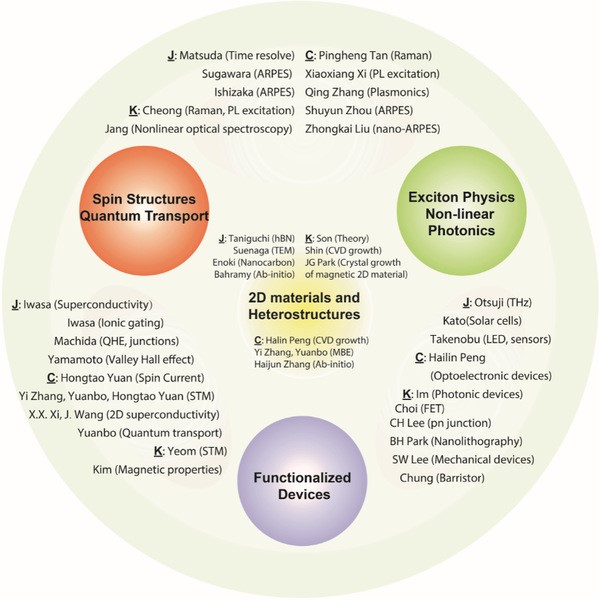Two-dimensional (2D) layered materials have recently attracted much interest due to their unique physical and chemical properties and potential applications in electronics, optoelectronics, spintronics and valleytronics. A wealth of unusual physical phenomena occurs when charges are confined into a plane lattice and dominated by their two-dimensional structural units. Research on 2D materials has thus become a major branch in the field of materials sciences. Since a large amount of research budget has been invested in 2D materials researches in Asian countries, Asia has nowadays become a leading area of the world for 2D material community. According to the statistics by Prof. Castro Neto in National University of Singapore, China, Korea and Japan were ranked as 1, 4, 3, respectively, in terms of academic publications, and 1, 3, 4 in terms of patents. In order to take a leading role, Asian countries are organizing two major international conferences every year inviting topnotch scientists from all over the world and try to boost the related research for applications. However, Asian countries still lag behind the United States and Europe in fundamental physics of 2D materials. Since industrial application or commercialization cannot be successful without a firm foundation of basic research, it is important for the Asian countries to strengthen basic research in 2D materials. Since there are already several groups in these countries carrying out frontier research, forming an alliance of leading scientists from the three countries would be a great step forward and be beneficial to the scientific advancement in all three countries.
The purpose of this A3 Foresight Program is to establish a world-leading COE of 2D materials and to cultivate the next generation researchers. To realize this goal, (1) we will support further individual collaborations among A3 countries, (2) we will hold three seminars per year (one per country) including a summer or winter school for students and young researchers, and we will also organize international conferences, and (3) we will support the mutual exchanges of young researchers including PhD students. Our main focus is on such non-graphene 2D materials and their van der Waals heterostructures, which are fabricated by stacking various monolayer materials. With such novel 2D materials and artificial heterostructures, we are anticipating observing novel lattice structures and electronic properties which cannot be achieved in conventional bulk materials. Also, with such unique structures, we will realize unique optical and electronic devices.
Among a wide variety of research directions of 2D materials, we will focus on physical aspects and related device functions. In particular, the emphasis will be given on the following four subjects:
(1) Growth/characterization of 2D materials and van der Waals heterostructures
(2) Spin structures and quantum transport
(3) Exciton physics and non-linear photonics
(4) Functionalized devices

The research topics on 2D materials of A3 foresight project.
The A3 consortium was made so as to maximize the potential of the A3 countries. The three countries’ activities are highly complementary: in short, Japan, Korea, and China are strong in basic physics, device physics, and materials synthesis and characterization, respectively. The researchers from the 3 countries will contribute to one or more of the four main topics, and they can be assigned as follows, as shown in below figure.
(1) Growth/characterization of 2D materials and van der Waals heterostructures
(2) Spin structures and quantum transport
(3) Optical properties (Exciton physics, SHG, MOKE, THz)
(4) Functionalized devices
The distribution of the researchers clearly demonstrates the complementary nature of the three countries and the comprehensiveness of the expertise. A number of achievements have been published from the international collaborations between the three countries, and this program will not only support existing collaborations but also stimulate new collaborations. According to the statistics explained above, the alliance of China, Korea, and Japan through the A3 project will make this geographically close countries the word-top and largest community in the 2D materials researches.
In order to cultivate the next generation of researchers, we will organize a summer or winter school every year. These schools will be open to those who are not members of the consortium so that a wider audience could benefit from them. This will particularly benefit the students in the country where the school is held. For this reason, we will hold three schools during the first two years, one at each country. The lecturers will be recruited among the participating scientist, but some external experts will be invited, if necessary. In addition, we will include a tutorial session at regular seminar meetings so that the students can learn some latest developments in the field.
